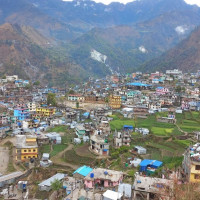- Monday, 19 January 2026
Wheat production in Bajura increases after the use of modern technology
By Sher Bahadur Sarki,Bajura, Apr. 13: The lack of a modern cultivation system and the use of old varieties of seeds led to a reduction in wheat production in Bajura a few years back.
Wheat production started increasing after the Agricultural Centre, Bajura provided knowledge to boost wheat cultivation. The Agriculture Knowledge Centre has been motivating farmers to plant new varieties of seeds using modern technology.
Compared to traditional farming, the production of wheat has increased after farmers cultivated wheat using new technology, said Deepak Thapa, the chief of the Agriculture Branch of Budhiganga Municipality.
He said that although the cultivation area has decreased, there has been a significant increase in terms of production lately. He said, "Wheat has grown better in places having good irrigation facilities. Due to the lack of timely rain, the wheat production will likely be less this year in hilly areas."
Wheat production could not increase because people planted the local seeds for a long time and did not use fertiliser properly. Wheat is cultivated in various places, including Himali, Swamikartik, Jaganath, Budhinanda, Badimalika, Gaumul, Budhiganga, Triveni and Chhededaha in Bajura.
Locals said that in the northeast region of the district, where the river banks and irrigation facilities have been managed, wheat grows well, but in slope areas, wheat production is low.
Wheat production is low in places like Badimalika Gaumul Chhededaha in the lower region, as local varieties of wheat are mostly planted. Farmers in Bajura plant wheat in November and start harvesting from mid-April.
Farmers here recently planted wheat of new varieties, including Pasanglamu, WK1214, Danphemonal and Swargadhari. However, most of the farmers are using the old local varieties of wheat.
Bajura has 230,037 hectares of land, out of which 22,000 hectares is agricultural land. Only 5,235 hectares of land is irrigated throughout the year.
Wheat is the winter crop and the production is largely determined by rain water in the area lacking irrigation. The production increases if there is sufficient winter rain and the production will decrease if it does not rain in winter.
Only 20 per cent of the total cultivated area in Bajura has irrigation facilities. Even now, 80 per cent of the land is cultivated with rainwater.
Thapa said that it is very necessary to expand the irrigation facilities to increase production and contribute to food security in the district. Wheat is cultivated in an area of 10,460 hectares, and around 17,782 tonnes of wheat is produced each year in Bajura.









-original-thumb.jpg)







